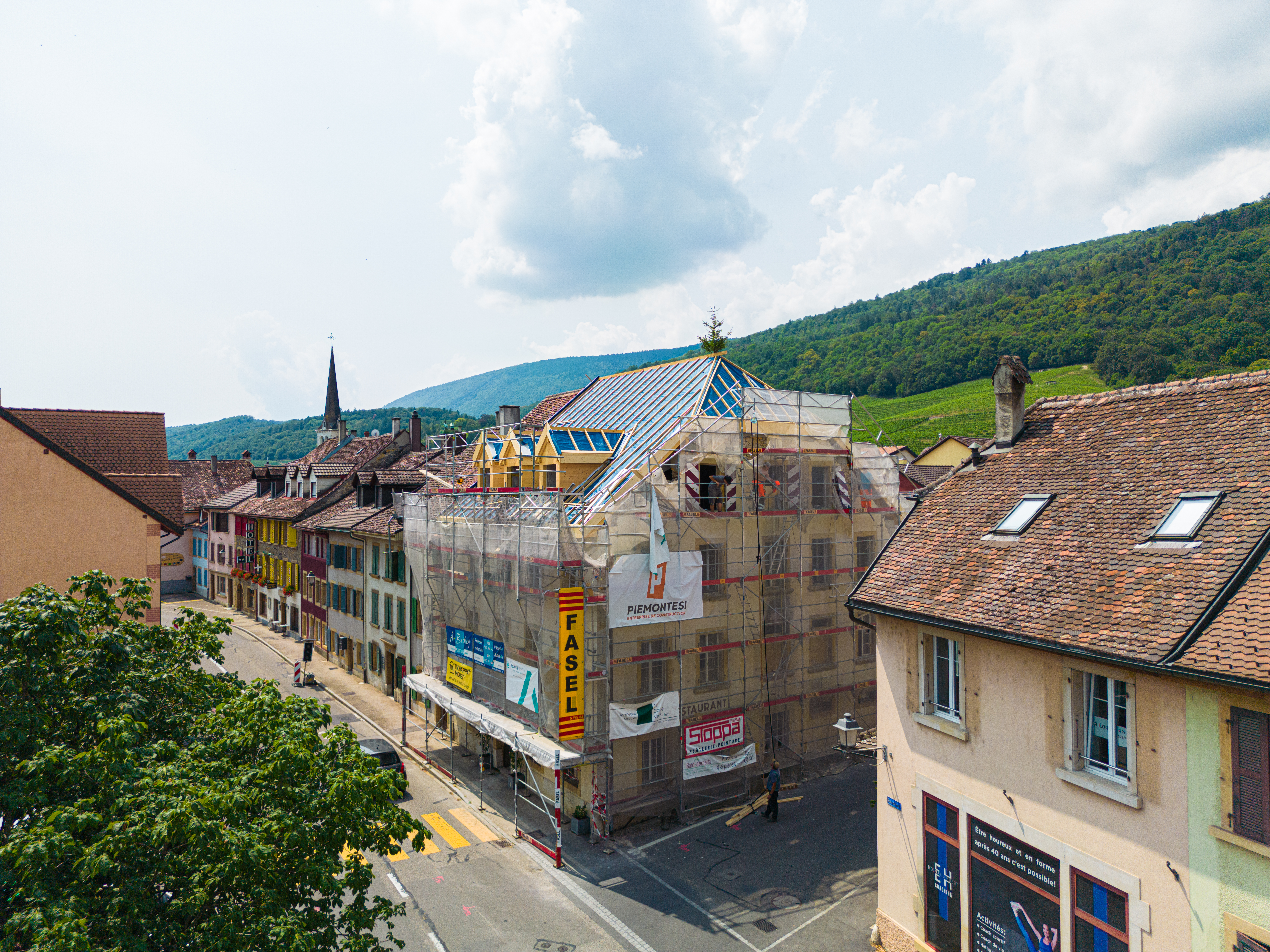How do you restore and adapt a 17th-century building to modern living standards while meeting the highest acoustic requirements? Here, we share the story of how Posi-Joist contributes to comfort and acoustics in an advanced restoration project in the Swiss town of Cressier.
This impressive stone building is situated in the picturesque village of Cressier in the Jura Mountains, a place where wine has been cultivated for centuries. The house has undergone numerous transformations over the years. From being a part of the local wine production with a wine cellar on the ground floor, it has evolved into a multi-residential building with office spaces. Unfortunately, a few years ago, the building was ravaged by fire, leaving only the 300-year-old stone walls standing.
So, how do you restore and transform a 17th-century building into the 21st century while meeting the strictest building regulations for sound insulation? We spoke with architect Laurent de Marta and contractor Pascal Schwab, who shared insights into the meticulous and comprehensive restoration process.

Improved Sound Insulation
Architect Laurent De Marta specializes in restoring and renovating old buildings. “Our client used to live in the house and rented out parts of it. Sound insulation was virtually non-existent, and you could hear everything from one floor to another. The post-fire renovation provided an opportunity to introduce modern sound insulation between the floors, which was one of the main requirements from the client,” Laurent de Marta explains. It’s worth noting that the client himself is an expert in acoustics and sound insulation, so the expectations were high, and he had specialized knowledge in the field.
Construction Challenge
The stone building was completely emptied after the fire, leaving the four walls at risk of collapsing without support. “The challenge was how to integrate the modern floors with the existing stone walls. The new floors we designed with new joists are there to help connect the different parts of the building,” says Laurent de Marta. He collaborated on the project with master builder Pascal Schwab, who has specialized in timber construction for over 40 years. “The most challenging part of this construction was crafting and recreating the large, heavy beams. It’s a very old building from the 17th century, and none of the walls are straight; they all have different heights. But we had to get precise measurements and then find a solution for the construction,” explains Pascal Schwab. “The masonry is almost a meter thick on the ground floor and decreases in size floor by floor to just over half a meter at the top. We needed to connect the beams to the existing walls. A real challenge was to find a system that offered good sound insulation while keeping the walls together,” Pascal Schwab continues.

Posi-Joist: The Ideal Solution
Constructing floors to support 300-year-old stone walls was a complex maneuver, but MiTek’s Posi-Joist flooring system proved to be the ideal solution. For Laurent De Marta and Pascal Schwab, it was their first time working with Posi-Joist.
It was a suggestion from our client, who is an expert in wood and sound insulation, and he said it’s the new way to address the issue of floor heights and sound requirements,” explained Laurent.
The unique open structure of Posi-Joist made it a perfect fit for this project. Laurent elaborated, saying, Posi-Joist is a system where we can not only run everything parallel to the beam but also, due to its open structure, we can place installations like electrical, heating, and plumbing within the floor joists.”
Easy On-Site Assembly
The use of Posi-Joist was also greatly appreciated by Pascal’s on-site team. “My builders appreciated working with a material that was lightweight yet very sturdy. It works very well for such an old building, and I believe it will meet the high sound requirements,” said Pascal. He continued, “A significant advantage of using Posi-Joist is that it’s prefabricated off-site and customized to precise measurements before delivery. Combined with accurate digital measurements of the 300-year-old stone wall building, this ensured success in execution, allowing for a final assembly that worked perfectly and quickly on-site.”
Where New and Old Converge
“For me, the most exciting part of this project is seeing this old building come back to life. Secondly, I’ve enjoyed the challenge of using a new product I’ve never used before and seeing how it perfectly addresses the challenges we had,” remarked Laurent. He continued, “This is an excellent example of how we work together. We love transforming old buildings, blending new and old, adapting new and current regulations and standards with old masonry, wood, and carpentry. Making all of this fit together is our passion.”
At MiTek Sweden, we are delighted that Posi-Joist enabled this restoration and contributed to it. We look forward to seeing it completed and are proud to be a part of the future of the construction industry in Switzerland.”



